From the depths of the Earth to the glittering works of art that adorn our wrists and fingers, diamonds symbolise beauty and power. Their journey of a diamond from mine to masterpiece is a complex and fascinating one, encompassing exploration, extraction, and, finally, a meticulous creation process.
Key Takeaways From This Article
- Diamonds are highly valued for their beauty, power, and wealth and hold immense sentimental value.
- The origins and exploration of diamonds involve geological mapping and analysing rocks and soil samples in geographic locations such as kimberlite pipes and ancient river beds.
- Responsible diamond mining practices ensure ethical sourcing, avoiding child labour and conflict diamonds.
- Diamond cutting is an intricate art that transforms rough diamonds into polished masterpieces, and quality is assessed based on the four Cs: Cut, Clarity, Colour, and Carat Weight.
The Allure and Significance of Diamonds
Diamonds are a luxurious symbol that often hold immense sentimental value. Historically, they've been given as a token of romantic love, used to express commitment and loyalty, and as a symbol of wealth and power.
In modern times, diamonds are still sought after for engagement rings and other jewellery, but their use in broader fashion has also become a trend. Diamonds are often used to adorn clothing, accessories, and watches and as a centrepiece to a luxury lifestyle.
The romantic symbolism of diamonds is still a powerful force, but modern trends have also embraced their beauty and value. Diamonds aren't only a sign of wealth but a timeless representation of commitment and sentiment.
Classic Diamond Tennis Bracelet 4.00ct G/SI in 18k White Gold
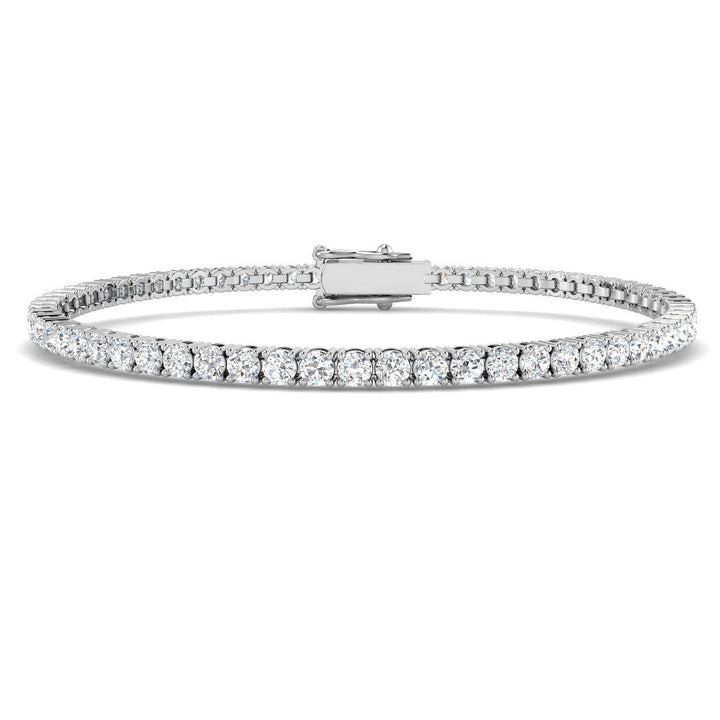
£3,697.00
£6,657.00
Handcrafted, ethically sourced diamonds beautifully arranged in sparkling 18k white gold form the base of this delightfully elegant tennis bracelet from our UK designers and craftsmen. A piece that overflows with style and elegance that we're sure will be a… read more
Unearthed Brilliance - The Mining Process
Mining is the process of extracting rough diamonds from the earth. It's a laborious and intricate process undertaken by miners and geologists to unearth these gems of extraordinary brilliance and significance.
The journey of a diamond from mine to masterpiece begins with the mining process.
The Origins of Diamonds
Formed over millions of years, diamonds are created deep within the Earth's crust. Their origin can be attributed to several mineral properties, geographic locations and geological formations:
* Mineral Properties:
- Carbon atoms create a unique atomic structure
- High temperatures and extreme pressures
- The presence of other elements in the surrounding environment
* Geographic Locations:
- Kimberlite pipes
- Ancient river beds and beach deposits
* Geological Formations:
- Volcanic eruptions
- Sedimentary layers
- Metamorphic rock formations
The origin of diamonds is a complex process still being studied and explored. By understanding the minerals, geographic regions and geological formations, we can uncover the mystery of the diamond's journey from mine to masterpiece.
1.00ct Baguette and Round Cut Claw Set Diamond Cross in 18k White Gold
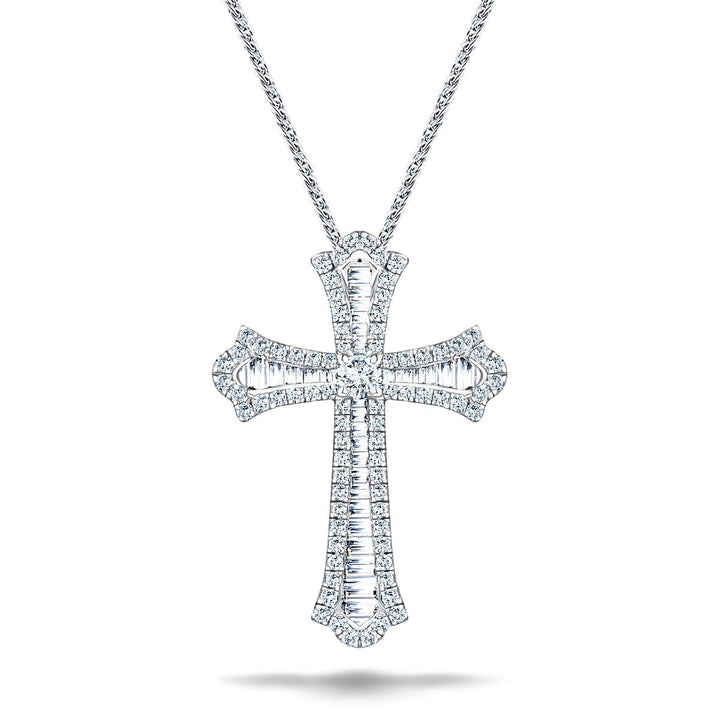
£1,947.00
£2,477.00
This dainty and luxurious cross pendant is a classic piece that offers gorgeous sparkle. With sustainable G/SI quality diamonds in fine white gold, it makes the perfect gift for any special occasion. UK hallmarked and the diamonds used are conflict-free.… read more
Finding the Gems: Diamond Exploration
To find diamonds, an exploration of potential diamond deposits must be conducted. Geological mapping is essential to identify potential areas where diamonds may be found. This process involves analysing the geology of a site, including the rocks, minerals, and other geological features.
Mineral exploration involves analysing rocks and soil samples from potential diamond sites to determine if they contain diamond-bearing deposits. This type of exploration can be expensive and time-consuming but is essential for the diamond industry.
Ethical sourcing is also essential, ensuring diamonds are mined responsibly with respect for the environment, local laws, and human rights.
The Mining Processes
The mining of diamonds is a complex process that involves a variety of tools and techniques. Open-pit, underground, and alluvial mining are the most common methods used to extract diamonds from the earth.
Each method presents its own unique set of challenges and rewards.
Open-pit Mining
Open-pit mining is the process of extracting diamonds from the earth's surface. It's done by blasting away rock layers with explosives and using heavy machinery to dig and haul away the diamond-bearing ore. During this process, dust control is necessary to protect the workers and the environment, while labour rights must be respected.
Here are the main steps of the open-pit mining process:
- Drilling: Using specialised machinery to create a hole deep into the ground.
- Seismic Surveys: Locating diamond-bearing ore deposits.
- Blasting: Using explosives to break the rock layers and release the ore.
- Hauling: Using heavy trucks to carry the ore to the processing plant.
- Processing: Separating the diamond from the ore using special equipment.
Underground Mining
Underground mining is an alternative to open-pit mining and is typically used when diamond deposits are too deep to access with open-pit methods. In this method, miners drill horizontal or vertical tunnels into the ground and use techniques such as blasting to extract the diamonds.
Underground mining has a significantly lower carbon footprint than open-pit methods; however, it's more expensive and dangerous due to hazardous gases and the potential for cave-ins. Drilling methods used in underground mining include hydraulic, pneumatic, and rotary drilling.
Underground mining is also used to determine the value of diamonds by measuring the depth of the diamond deposits. Ultimately, the diamonds are extracted and sent to the cutting and polishing process.
Alluvial Mining
Alluvial mining is a type of mining that involves collecting diamonds that have been eroded by rivers and deposited in river beds and along the shorelines. This mining method is distinct from underground mining, as it doesn't require excavation or access to the diamond deposits.
The alluvial mining process includes:
- Sorting: Diamonds are separated from other materials collected during the process.
- Washing: Diamonds are separated from other materials by using water and sieves.
- Separating: Diamonds are further separated from other materials using various methods, such as dense media separation, jigs, or X-ray fluorescence sorting.
The alluvial mining process is relatively simple compared to other mining processes. It allows for diamonds to be collected from riverbeds and shorelines, making it an excellent choice for those who desire freedom and independence.
Ethical Considerations
Responsible diamond mining considers the process's environmental and social impacts. To avoid child labour, conflict diamonds, and unsustainable sourcing, many diamond mining companies have implemented ethical practices that ensure transparency and the protection of human rights.
This includes a commitment to avoid using child labour, to ensure fair wages for employees, and to promote sustainable sourcing of diamonds. Additionally, some companies have adopted policies that ensure that diamonds are responsibly sourced and tracked throughout the supply chain to ensure they aren't used to finance conflict.
These practices help ensure that the diamonds are ethically sourced and that the diamond mining industry contributes to a more sustainable future.
From Rough Stone to Radiant Sparkle - The Art of Diamond Cutting
The diamond cutting process is an intricate and delicate art.
It involves transforming a rough diamond into a radiant sparkle.
Skilled artisans combine techniques including bruting, faceting, and polishing to achieve this transformation.
Blue Sapphire 1.00ct & 0.60ct G/SI Diamond Necklace in 18k White Gold
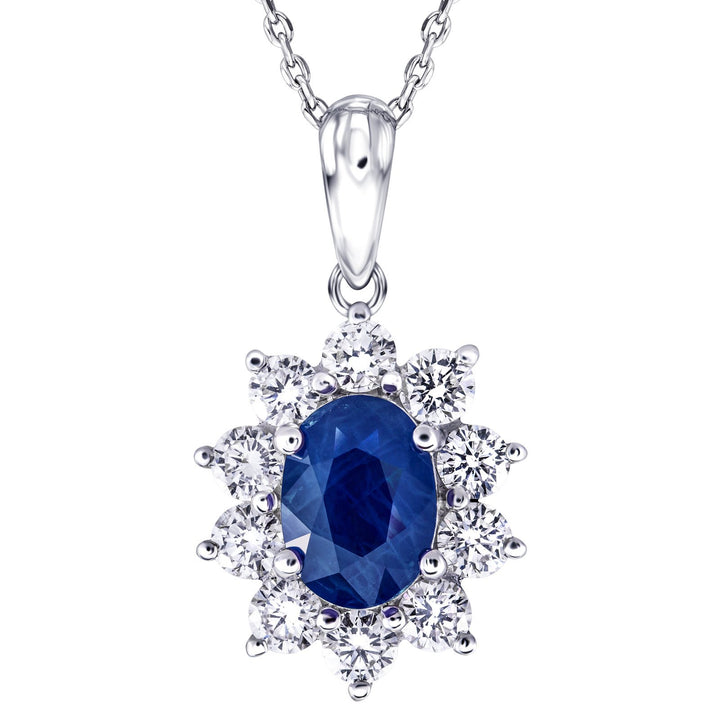
£1,517.00
£2,597.00
This exquisite necklace is a perfect addition to any jewellery collection. A stunning blue in color, this majestic necklace will be a focal point in any outfit. This is a stunning and unique alluring piece. The radiant blue stone is… read more
Understanding Diamond's Rough Form
Seeing a diamond's rough form is essential to understanding its journey from mine to masterpiece. Exploring the rough form of a diamond through gem exploration reveals the potential of its beauty and sparkle.
Here are the three key aspects of rough diamond form:
* Structure:
* Its shape
* Size
* Facets
* Quality:
* Colour
* Clarity
* Carat
* Inclusions:
* Internal characteristics
* External characteristics
The Diamond Cutting Process
The diamond cutting process is a highly skilled craft that requires great precision and transforms a diamond from a rough form to the polished masterpiece it becomes.
The process includes using bruting techniques, such as cleaving and sawing, and involves polishing methods, such as grinding and polishing, to achieve the desired shape and size.
Diamond grading is an essential part of the cutting process, as the quality of the diamond is determined by evaluating the proportions, symmetry, and polish.
The brilliance and fire of the diamond are then enhanced through the careful and precise execution of the cutting process.
Baguette Channel Diamond Full Eternity Ring 1.15ct in Platinum 3.4mm
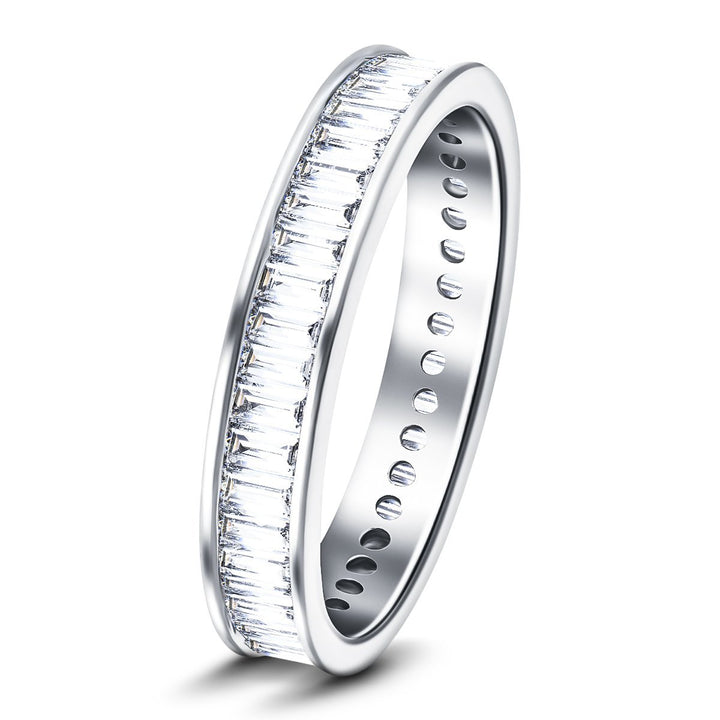
£1,927.00
£3,147.00
This eternity diamond ring has been gorgeously crafted out of lustrous white platinum and channel set with 1.15ct sparkling baguette-cut, ethically sourced diamonds. These G/SI quality diamonds add sophistication to the stunning design from our UK craftsmen. This elegant full eternity… read more
Bruting
Bruting is a diamond cutting technique that involves splitting and cleaving the diamond to obtain the desired shape. It requires two diamond cutters to place two diamonds onto opposite sides of a spinning metal wheel. This wheel is covered with diamond dust, which allows the diamonds to be cut into the desired shape.
The process of bruting is both complex and delicate. The gem selection process requires a careful eye for colour, clarity, and carat weight. The diamond cutters must also ensure that the diamonds are ethically sourced and of the highest possible quality.
Additionally, the diamond cutters must be well-versed in several bruting techniques. These techniques include cleaving, sawing, and polishing. The diamond cutters must use the correct method to cut the diamond into the desired shape.
Overall, bruting is an essential step in the diamond cutting process. It requires skill, precision, and knowledge of bruting techniques to produce a high-quality diamond. Diamond cutters must be experienced and knowledgeable to create masterpieces from the mined gems.
Faceting
After bruting, the diamond cutters begin the process of faceting, which involves cutting and polishing the diamond to create a desired shape and maximise its sparkle. This process requires a skilled eye and a steady hand, as the gem must be cut to exacting specifications.
Inclusion clarity is one of the first things that must be determined. If there are any blemishes or imperfections, the cutter must decide how to cut around them. Colour grading is also essential, as the cutter must choose how to enhance the diamond's natural hues best.
Lastly, the cutter must determine the ideal cut to maximise the diamond's brilliance and fire.
Polishing
Polishing is the final step in the diamond cutting process, which involves buffing the facets to bring out the full brilliance of the gem. It's the process of:
* Enhancing diamond clarity:
* Examining the gem for blemishes and inclusions
* Using diamond cutting tools to remove imperfections
* Applying polishing techniques to create smooth and even facets
* Increasing diamond brilliance:
* Shaping the facets using various tools
* Creating contrast between light and dark facets
* Adding a mirror-like finish to the diamond
* Adding a sparkle to the gemstone:
* Applying a special polishing compound
* Utilizing specific techniques to create a scintillating effect
* Enhancing the diamond's fire and brilliance
Polishing is a delicate and precise process requiring skill and expertise to bring out the beauty of the diamond.
Channel Set Trilogy Crossover Ring 0.33ct G/SI Quality 18k White Gold
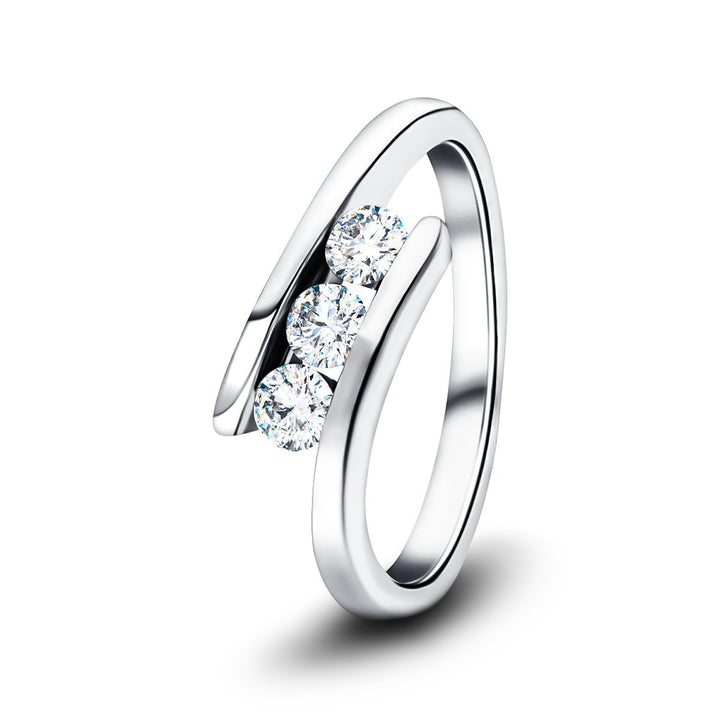
£887.00
£1,377.00
This trilogy diamond ring in 18K white gold is designed and handcrafted in the UK. The ring features three diamonds totalling 0.33CT. Each diamond is of G/SI quality and ethically sourced. The three round, brilliant-cut diamonds are secured in an… read more
Quality and Grading: Introduction to the "Four Cs" and the role of professional grading
The Four Cs of diamond quality--Cut, Clarity, Colour, and Carat Weight--are essential to understand when assessing a diamond's value. Professional grading is necessary to evaluate each of the Four Cs accurately. Grading criteria must be set to ensure a diamond's quality. Laboratories provide certification to ensure that a diamond meets the set standards.
Consumer education is also important, as understanding the Four Cs will help buyers make informed decisions. Expert jewellers can provide helpful advice about value and quality, and their trained eyes can detect subtle nuances in a diamond's cut, clarity, colour, and carat weight. With the proper knowledge and experience, a diamond can be judged and valued correctly.
Setting the Stage - Incorporating Diamonds Into Jewellery
Once the diamond is graded and chosen, the next step is to create a masterpiece by incorporating it into jewellery.
This involves designing the piece, choosing the right setting to complement the diamond, and selecting from the many settings available.
Designing a Masterpiece
Expert jewellers carefully design a masterpiece from a diamond. The creative process requires a deep understanding of the diamond's physical and emotional properties and a keen eye for detail. Craftsmanship is key to producing a timeless work of art.
Creating a Design:
- Engagement rings often feature diamonds with unique shapes and settings made with cutting tools.
- Diamonds of all cuts and sizes are used to create a design that's both aesthetically pleasing and symbolic.
- The chosen design must be carefully crafted to highlight the diamond's unique characteristics.
Setting the Stone:
- Expert jewellers use specialised tools to set the diamond securely in its chosen mount.
- The stone must be placed in the setting so that it's secure and the mount is balanced.
- The diamond must be handled carefully to ensure the stone isn't damaged during the setting process.
Finishing Touches:
- Once a diamond has been set, the piece is carefully polished to create a smooth and lustrous finish.
- Final touches may include engraving, accent stones, or other decorative elements.
- When the masterpiece is complete, it will be admired and cherished forever.
Choosing a Setting
Jewellers consider the diamond shape and size when selecting the perfect setting for a masterpiece. Engagement rings often feature prong settings, which allow the diamond to be securely held in place and have the most light exposure, showing the diamond's brilliance.
Pave diamonds, which feature small diamonds covering the entire surface of the ring, provide a glamorous yet classic look. The type of setting used depends on the diamond's size and shape and the overall look the customer desires.
The jeweller's experience and expertise allow them to find the perfect setting to showcase the diamond's beauty and make it the centrepiece of the masterpiece.
7 Stone Semi Bezel Set Diamond Ring 0.75ct G/SI In Platinum
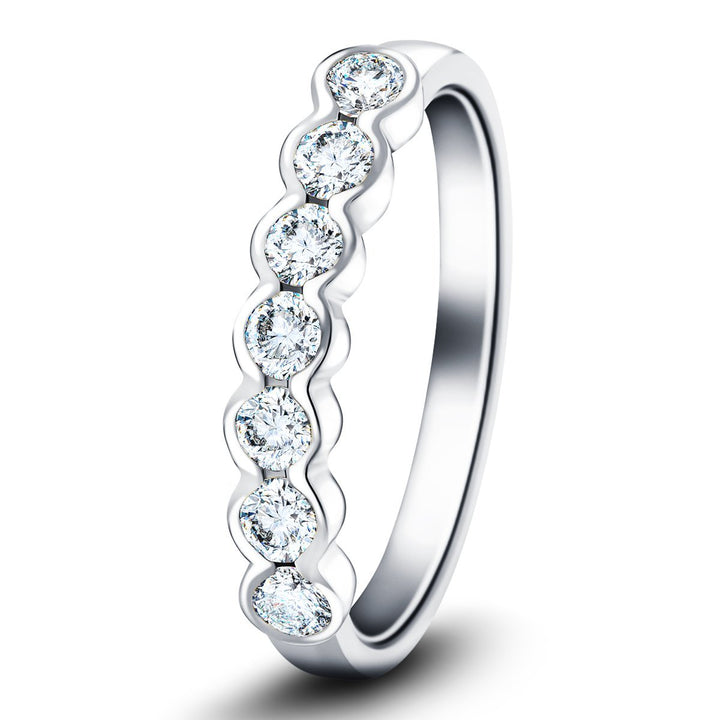
£1,427.00
£2,447.00
Crafted with genuine 0.75 carat G/SI round diamonds and set in platinum, it's the ideal choice for a natural and elegant appearance. The luxurious platinum ring is a great way to show off your appreciation for the special person in… read more
Types of Settings
Different settings are available to highlight a diamond's beauty, ranging from prong to pave settings.
Band Settings:
* Engagement Rings
* Wedding Bands
* Stackable Rings
Prong Settings:
* Solitaire
* Three-stone
* Halo
Bezel Settings:
* Semi-Bezel
* Full-Bezel
* Knife-Edge
The type of setting chosen for a diamond can dramatically affect the overall look. Band settings provide a classic, timeless feel, while prong settings allow the diamond to shine brightly. Bezel settings are a modern choice that protects the diamond while also making a statement. All of these settings come in various styles and can complement any diamond.
The Final Creation: Assembling, Setting, and Polishing the Final Piece
After the diamond has been cut and its quality inspected, skilled jewellers assemble it into its setting, polish it to perfection, and create a masterpiece.
The setting is formed using various techniques such as prong setting, bezel setting, and channel setting. If desired, the jeweller can also engrave the diamond with a unique design.
After the diamond is set in its setting, it's inspected again and certified by a professional gemologist.
Lastly, the diamond is polished until it shines brilliantly.
The combination of the diamond's quality, the setting, and the polishing techniques used determine the diamond's price and its beauty.
With the right combination, the final product is an exquisite piece of jewellery that will last a lifetime.
Blue Sapphire 1.50ct & 1.00ct G/SI Diamond Necklace in 18k White Gold

£2,467.00
£4,447.00
It is a significant statement jewellery and a great gift for a loved one. For that special occasion, look no more. The UK hallmarked 18k white gold necklace is the perfect choice for that special occasion. The blue sapphire in… read more
Reflection on a Diamond's Remarkable Journey
The transformation of a diamond from its rough state to its finished form is genuinely remarkable. It's a journey that requires ethical sourcing, gem identification, and diamond valuation, all of which have improved in recent years.
The following are the steps in the journey of a diamond from mine to masterpiece:
* Exploration: Mining operations must identify favourable areas for diamond deposits.
* Mapping: Geologists use innovative methods to map diamond-bearing terrain.
* Extraction: Professional miners use safe methods to extract diamonds from the earth.
* Refinement: The diamonds must be carefully cut and polished to reveal their beauty.
* Cutting: Specialty tools shape and enhance the diamond's facets.
* Setting: Creative designers frame the diamond's brilliance using precious metals.
* Polishing: Skilled artisans use modern techniques to refine the diamond.
* Valuation: Jewellers must assess the diamond's true worth.
* Certification: Professional appraisers use the latest technologies to identify and value diamonds accurately.
* Marketing: Jewellers use unique strategies to promote the diamond's beauty.
* Sale: Customers must be confident they're making an ethical purchase.
The journey of a diamond from its raw form to a work of art is truly remarkable!
Additional Tips for Newcomers
For newcomers to diamond jewellery, it's important to understand basic care practices and fun facts about diamonds.
Knowing these will help novice diamond buyers make informed decisions and appreciate the remarkable journey of a diamond from mine to masterpiece.
Gold Jewellery Cleaning Cloth Ultrasoft Polishing Cloths Cotton Fiber

£47.00
To clean gold jewellery, connoisseurs ultrasoft gold jewellery cleaning cloth & polish cloth. It removes and helps prevent tarnish. The inner lighter cloth cleans, and the darker outer cloth polishes. Connoisseurs ultrasoft polishing cloths are made with 100% cotton fibre,… read more
Care practices for diamond jewellery
Diamond jewellery requires proper care to maintain its beauty. Caring for diamond jewellery responsibly involves considering its sourcing, wearing, storage, and cleaning:
Sourcing:
- When buying, look for diamonds from socially responsible sources.
- Consider the environmental impact of sourcing diamonds.
Wearing:
- Incorporate careful wearing habits to reduce the risk of damage.
- Take off jewellery when engaging in physical activities.
Storage:
- Store each piece separately in a soft cloth or pouch.
- Keep away from heat, moisture, and direct sunlight.
Cleaning:
- Gently clean with a soft cloth to remove dirt and oils.
- Avoid harsh chemicals or steam cleaning.
Fun facts about diamonds
Fascinating and beautiful, diamonds have been prized throughout history for their rarity and brilliance. But did you know the mystery origins of diamonds?
Most diamonds come from kimberlite pipes and alluvial deposits in South Africa, Australia, and other parts of the world. They're mined and sold following strict sustainability standards, and some are even treated to enhance their colour, clarity, or other characteristics.
Diamond treatments have been used since the 16th century to improve the visual appeal of a diamond by concealing faults within the stone. Many of these treatments are undetectable to the human eye. It's truly amazing to think about the journey of a diamond from its mysterious origin to its carefully crafted masterpiece.
Certified Shoulder Set Diamond Engagement Ring 1.35ct G/SI in Platinum

£6,757.00
£12,777.00
Show her how much you love her with this beautiful, one-of-a-kind engagement ring that has been specially created for her. The stunning combination of diamond accents and delicate filigree designs will make her feel as though she's walking on air.… read more
Discover The End of a Remarkable Journey of a Diamond At All Diamond
The journey of a diamond, from mine to masterpiece, is remarkable. From exploration to polishing, it's a complex process that requires skill, expertise, and ethical considerations.
Each step of the journey is integral to the end result, creating a truly exquisite and timeless piece of jewellery. The creation of a diamond masterpiece is a testament to the craftsmanship and skill of those involved in the process.
Discover the enchanting allure of our diamond jewellery collections; each piece is a testament to a diamond's remarkable journey from the mine to your jewellery collection!
Every piece in our collection is designed and handcrafted in the UK, ensuring a unique charm and superior quality. With All Diamonds, your satisfaction is our priority. We offer a lifetime workmanship guarantee and a 30-day return or exchange policy on all our pieces.
So why wait?
Unearth the brilliance of our diamond collections today. Let your journey with All Diamonds begin now. Explore our online store and find the perfect diamond masterpiece that resonates with your style and spirit.




